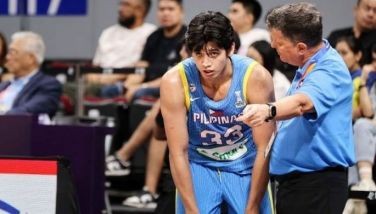Cheats in chess
Cheating scandals in sports greeted the first quarter of 2008. Allegations of steriods use and Human Growth Hormones (HGH) injections implicated several
The royal game of chess was not spared. Organizers have already cascaded tournament sites with magnetic signals to jam secret wireless communications. And they have good reasons.
At the US World Open in
Cheating charges are nothing new in chess. In the 1962 world candidates tournament in
* * *
A rare sideline (positional exchange sacrifice), which the world champion must have studied and re-appraised, helps him to another fine victory. This game is welcome for some supplementary light on the variation which has been known so far as favorable for White.
Linares 2008
W) A. Shirov g 2755 ESP
B) V. Anand g 2799
Sicilian Defense
1. e4 c5
2. Nf3 d6
3. d4 cxd4
4. Nxd4 Nf6
5. Nc3 a6
6. Bg5 e6
7. f4 Nbd7
After 7...h6 8. Bh4 Be7 9. Qf3 Qc7 10. 0-0-0 Nbd7 11. Be2!? (11. Bd3 g5 12. fxg5 Ne5 13. Qe2 Nfd7 14. Nf3! Nxf3 15. gxf3 hxg5 16. Bg3 slightly favors White) 11...Rg8!? 12. Qg3 g5 13. fxg5 Ne5 14. Nf3 Nfd7 15. g6!? Rxg6 16. Qh3, White has a slight edge.
8. Qf3 Qc7
9. 0-0-0 b5
10. Bd3 ...
White has a number of possibilities; 10. e5 and 10. Bxb5 are both fairly popular, but the system chosen by Shirov is more solid and leads to positional struggle in which White has scored fine successes.
10... Bb7
11. Rhe1 Qb6
Polugaevsky’s well-known idea which has become quite popular in the 70s.
Anand knows the Najdorf well and must have good reason for making this move. Yet the conventional 11...0-0-0 seems safer. The text allows the dangerous 12. Nd5!
12. Nb3?! ...
Seems passive. Stronger is 12. Nd5! exd5 13. Nc6!, when White has a powerful attack for the piece although the win so far is inconclusive.
12... Rc8!
Anand improves on 12...b4 which Kariakin tried against Shirov in the 2007 World Cup in
13. Qh3 ...
Intending to pry open the center with 14. e5.
13... Rxc3!
An typical exchange sacrifice on the c-file, shattering White’s queenside pawn structure.
14. bxc3 Qc7
15. Kb1 Be7
16. e5 ...
White is forced to open up the position in view of Black’s coming threats along the c-file. The alternative 16. Qg3 is also good.
16... dxe5
17. f5?! ...
Hardly a good advance. Better is the simple 17. fxe5! when White obtains a dangerous attack. For instance 17...Nxe5 (if 17...Nd5 18. Bxe7 Nxc3ch 19. Ka1 Nxd1 20. Bb4 Nc3 21. Qg3 g6 22. Bd6 Qc8 23. Rf1, White is better) 18. Qg3 Bd6 19. Bxf6 gxf6 20. Be4! and White has the upper hand.
17... Nd5
18. Bxe7 Kxe7!?
The King safely defends e6. Now White’s task to open up the position is far from easy.
19. fxe6 fxe6
The doubled e-pawn makes it hard for White to attack the Black king.
20. Qg3 g6
21. Rd2 Rc8
Now Black has what he aimed for and holds the edge because of the situation on the queenside.
22. Qg5ch? ...
Not the right check after which White is strategically lost. It is worth studying if White has better chances with 22. Qh4ch, although after 22...N7f6 23. Rf2 e4 24. Bxe4 Nxc3ch 25. Kc1 Qe5, Black’s initiative is still dangerous.
22... Ke8
23. Qg4 ...
23. Bxg6ch?! doesn’t work because of 23...hxg6 24. Qxg6ch Ke7 25. Qg7ch Kd6 and the Black king escapes.
23... Nxc3ch
24. Ka1 Bd5
25. Re3 Nf6
26. Qh4 Qe7
The immediate threat is 27...Qa3 and mate. Also strong is 26...Qg7! with the idea of 27...e4, opening the long diagonal a1-h8.
27. Bf1 Bxb3
28. cxb3 ...
Obviously 28. axb3? Qa3 mates.
28... Nce4
29. Rb2 ...
There is nothing better. For example 29. Rxe4 Qa3 30. Bd3 Nxe4 31. Qxe4 Qc1ch 32. Bb1 Qxd2 and Black wins easily.
29... Rc1ch
30. Rb1 Qc5
0:1
30. Rd3 is met by 30...Qc2 and mate follows.
* * *
Solution to last week’s puzzle:
1. Bf4! ... If 1...b1=Q/b1=N 2. e4/Rc2 mates.
- Latest
- Trending




























